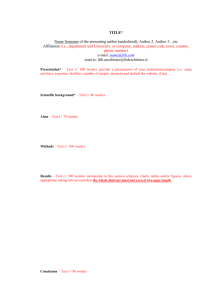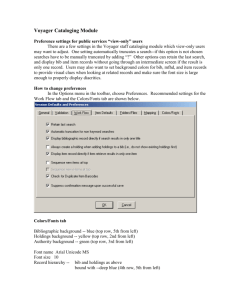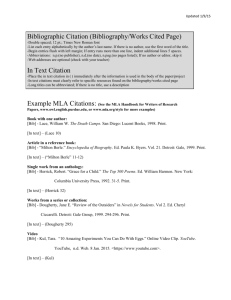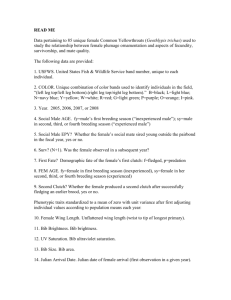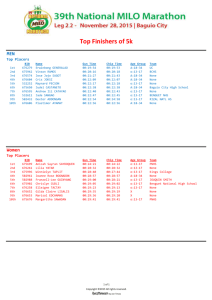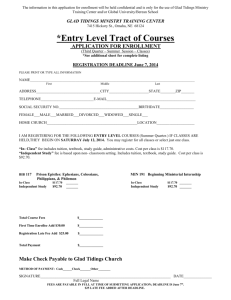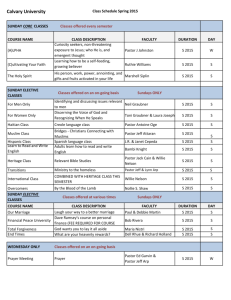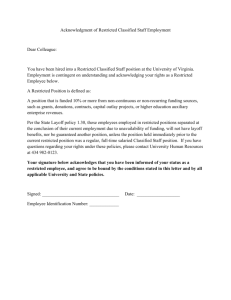Mining the Blob: There's Gold in the Directory!
advertisement
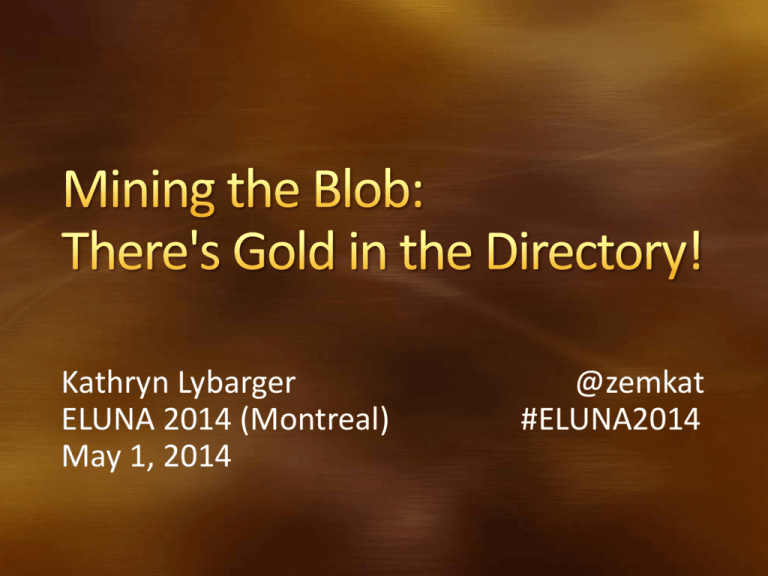
Kathryn Lybarger ELUNA 2014 (Montreal) May 1, 2014 @zemkat #ELUNA2014 Though the catalog: was created from raw MARC actually contains MARC still We are using indexes High-speed access to common elements Relationship between elements Some elements grouped into one index Some elements modified to be more useful MFHD_MASTER.DISPLAY_CALL_NO Call number as it would display PS7 .A6 1937 PS1000.A8 G53 1856 MFHD_MASTER.NORMALIZED_CALL_NO Normalized spacing so that things sort properly PS 7 A 6 1937 PS 1000 A 8 G 53 1856 Many indexed fields (including all 6XX) are indexed together in BIB_INDEX You can distinguish between them using the INDEX_CODE String functions MID – extract only part of a field MID(FIELD, start, length) LEFT, RIGHT – extract left or right side Aggregate functions MIN, MAX – minimum or maximum COUNT – how many match? How do I get this data? Just use the common backbone. How about this other data? Link in these more obscure tables. And this data? Use functions to extract and group. And what about this other thing? Oh… you’ll have to use the BLOB. Sorry. Binary Large Object A lump of binary data stored as a single entity in a database Not indexed into its individual meaningful parts Often, slower than pre-defined indexes In Voyager BIB_DATA (and friends) BIB_ID – record ID SEGMENT – actual binary data (990 bytes) SEQNUM – which segment (record may be longer) Functions GetAuthBlob(AUTH_ID) GetBibBlob(BIB_ID) GetMFHDBlob(MFHD_ID) Examples: GetField(GetBibBlob([BIB_TEXT].[BIB_ID]),’6’,1) GetSubField(GetFieldRaw(GetBibBlob([BIB_TEXT].[ BIB_ID]),’650’,1),’x’,2) “Binary” is a bit misleading Mostly readable characters Some control characters Subfield delimiter, end-of-field, end-of-record MARC record structure Leader Directory An index to the variable fields Variable fields First 24 characters of the MARC record Some of these will always be the same 10 – indicator count (always 2 – ind1, ind2) 11 – subfield code length (always 2, $b) Some vary with the record 00-04 – record length 12-16 – base address of data What is the shortest record in the catalog? What is the longest record in the catalog? (are these records any good?) MID(BIB_DATA.RECORD_SEGMENT, 1, 5) First five characters of the segment We want the smallest one of these Only check the first segment of a record SELECT MIN(MID(RECORD_SEGMENT, 1, 5)) FROM BIB_DATA WHERE SEQNUM=‘1’; This only gives the length We want the actual shortest record(s) SELECT BIB_ID FROM BIB_DATA WHERE SUBSTR(RECORD_SEGMENT,1,5) = (SELECT MIN(SUBSTR(RECORD_SEGMENT,1,5)) FROM BIB_DATA WHERE SEQNUM='1'); To avoid filling slides with SQL queries, I’ve made them available in a GitHub repository I encourage you to try my queries in Access, and let me know what you find in your catalog! http://github.com/zemkat/Voyager/queries 416 links – yikes! Occurs right after the leader From byte 24 to (base address of data) -1 Each variable field has a triplet (12 bytes) in the directory (three bytes) – tag (next four bytes) – length of field (next five bytes) – starting position Variable fields have indicators, subfield codes, subfield data Directory length = base data address - 24 (for leader) - 1 (field terminator for leader) - 1 (field terminator for directory) + 1 (since we start counting at zero) Directory length / 12 = number of variable fields A record with this leader has 22 variable fields: 01012nam a22002897 4500 Which record has the most fields? Which record has the fewest fields? (are these records any good?) Too many fields Links to every issue of a serial ISBNs for every volume Titles of every Slovak folk song ever Too few fields Provisional order records that never got overlaid Non-Roman alphabet “[ARABIC CHARACTERS]” Mystery from past catalog What are the smallest records with call numbers in their holdings? What are the smallest records with OCLC numbers? Smallest records by location? Which fields are we using? (how many records does each appear in?) Are we using any that we shouldn’t? What percentage of our records does each field appear in? Software Runs on linux, outputs Excel files Open source, available on github The Voyager tag table specifies: What is mandatory What may repeat Tag table can be bypassed: Preference in Cataloging module Bulk import How to find missing mandatory fields? (GDC!) Repeating fields that shouldn’t? (GDC!) How are we using this tag in Voyager? Are we using it consistently? How would this look in our OPAC display? Software Runs on linux, outputs Excel files Two sheets: raw, grouped Open source, available on github Grouped to show common usage: Restrict to subscribers. Restricted subscribers. Restricted to subscribers. Restricted to scubscribers. Restricted to subesribers. Restricted to subsacribers. Restricted to subscibers. Restricted to subscribres. Restricted to subscribrs. Restricted to subsribers. Restricted to suscribers. Restricted to users. Restrictged to subscribers. Restrictricted to subscribers Restrocted to subscribers. Restrticted to subscribers. OCLC Bibliographic Notification (now in Worldshare Metadata Collection Manager) Informs you which of your records have changed in OCLC Download those records Challenges Avoid overriding local improvements Too many records change to look at them all! How much have they changed (for us) ? Focus on: Which records have grown the most? (Byte size or number of fields) Compare size of new record against equivalent in Voyager Sort this list to only look at large improvements (software unreleased) What do our MARC records look like, on average? What types do we have? How do they vary? Investigate using principal component analysis of directory data (in progress) Kathryn Lybarger Kathryn.Lybarger@uky.edu GitHub: http://github.com/zemkat/Voyager/ Blogs: http://pc.blog.zemows.org http://problem-cataloger.tumblr.com http://library-computer.tumblr.com @zemkat
